
Sanil is the Founder of Ayruz Data Marketing, a global digital solutions company helping businesses scale through remote talent, AI-driven strategies, and performance marketing. With over 15 years of experience across the US and UK markets, he’s advised Fortune 500 brands and startups alike on growth, data, and digital transformation. A member of the Forbes Agency Council, Sanil is known for blending strategy with execution to drive measurable business outcomes.
Sanil Subash Chandra Bose
Blogs

Understanding the Difference Between Events and Conversions in GA4
Google Analytics 4 (GA4) is a powerful tool for tracking and analyzing user interactions on your website. Two terms, “events” and “conversions,” are often used, and while they might seem similar at first glance, they represent distinct actions in GA4. Understanding the differences between these two metrics is crucial for effectively evaluating the success of your marketing campaigns.
What Are Events in GA4?
Events in GA4 measure specific actions or occurrences on your website. These actions range from button clicks and downloads to purchases, scrolling, and page views. Some events are automatically tracked by GA4, making it easier to understand user behavior. These automatic events include:
- First_visit: Collected the first time a user visits your website, and GA4 uses this event to create the “New Users” datapoint in reports.
- Page_view: Reports page views on the page the user is currently viewing.
- Session_start: Determines when a user’s session begins. After 30 minutes of inactivity, a new session_start event is triggered.
- User_engagement: Engagement is reported when a user spends at least 10 seconds on the website and is collected periodically.
These automatic events cannot be turned off. Additionally, GA4 allows Enhanced Measurements to automatically track other events, including scrolls, outbound clicks, site searches, video engagement, and file downloads. Moreover, you have the flexibility to create custom events tailored to your specific website goals.
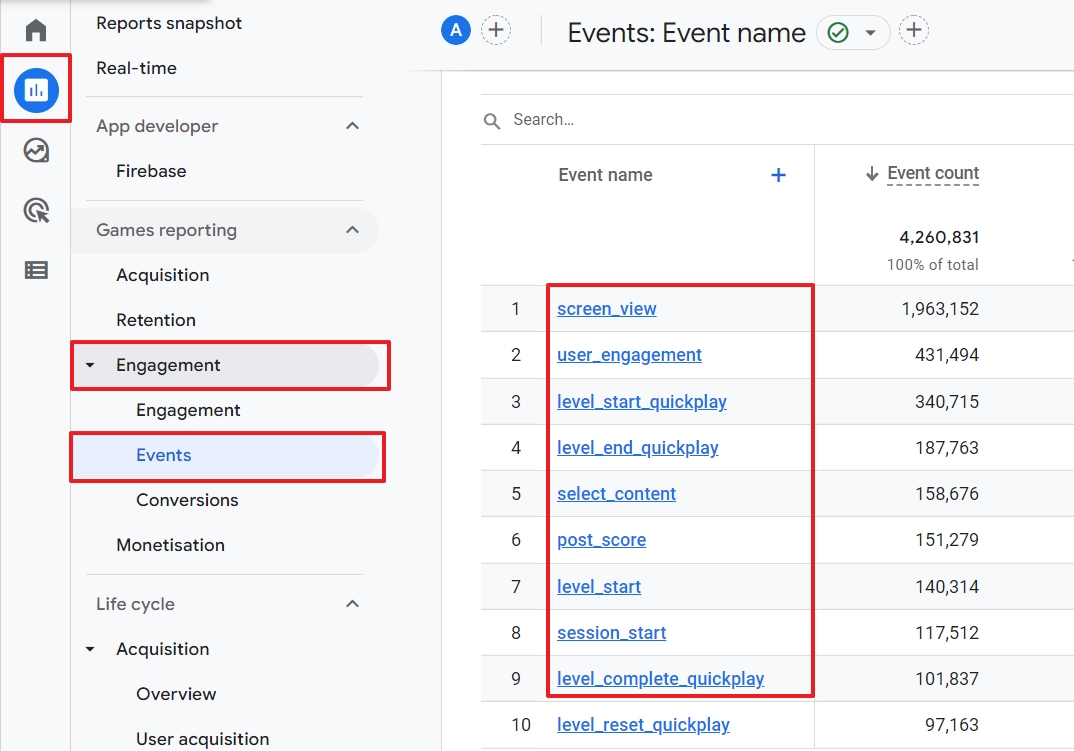
What Are Conversions in GA4?
Conversions in GA4 represent significant actions that users take on your website and are deemed necessary to your business. These actions are often critical metrics of success. Conversions in GA4 replace the concept of goals from Universal Analytics.
To measure a conversion in GA4, you must create a custom event and designate it as a conversion. Each conversion you want to track requires a dedicated event. Everyday events marked as conversions include:
- Phone calls
- Destination goals
- Purchases
- Downloads
- Appointment bookings
Some conversions, such as phone calls, must first occur as an event on your site before you can mark them as conversions in GA4.
Vital Differences Between Events and Conversions:
Now, let’s summarize the vital distinctions between events and conversions in GA4:
- Scope: Events capture various user actions, while conversions focus on specific, valuable actions.
- Purpose: Events help you understand user behavior, while conversions measure the success of your business goals.
- Counting Mechanism: Events are counted every time, whereas conversions are typically counted once per session.
- Quantity: Multiple events can occur on a single page, while conversions are usually limited to a few.
- Configuration: Some events can be tracked automatically in GA4, while conversions require manual setup.
By grasping these differences, you can effectively leverage events and conversions in GA4 to gain valuable insights into user behavior and measure the success of your marketing efforts. This understanding will empower you to make data-driven decisions and optimize your website’s performance.

How The Learning Capacity Of Human Beings Vary Listening to Long Lectures?
“Are you with me?”, the obvious way a teacher measures the attentiveness of students. The long-established question takes its place more prominent in classrooms these days. It seems that most of the new generation lecturers find it alarming that getting student attention is increasingly difficult compared to preparing the lecture notes! The lecture hours can last up to 45 to 60 minutes, and what students usually commit to is “poor” attention. Addition to the distractions the present era owes, they brood over in thoughts, fidget or doze off in between, there is only passive absorption of information and apparently, teachers go exasperated. During the start of the lecture, there might be high levels of responsiveness, but as the session progress, you may even see a row of students slumped on their desks or being restless, suggests a drastic drop in attention.
Attention and performance levels vary from student to student, studies indicate that performance can be assessed by;
- The not-scribbled legible part of the lecture notes taken down
- The ability of students to recall the class
- The questions students can answer about the section of the lecture
Continued attention might fluctuate with the quality of the lecture, motivation, emotions, time of the day and other deviating factors. Lecturers involve in different activities to captivate students and increase the span of attention – visuals, video clips, demonstrations, encouraging students to participate in a quick chit-chat, to take a break, even asking to pick the occasional sleeper of the class. Many types of research and surveys state that each student exhibits a different pattern of attention and performance levels, varying with lectures.
Attention graphs on lecture time and student performance can be a modest way to demonstrate it. If we focus on the reports by (Bligh, 1998) it divides into four.
Horizontal Line Graph
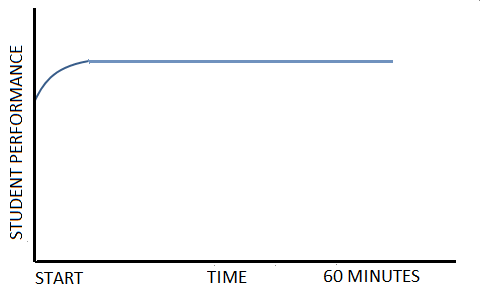
Student attention line in a lecture (Bligh 1998)
The graph shows student performance along Y-axis and lecture duration on the X-axis. This graphical representation reminds us of those beautiful lecture sessions, never to be missed or look for any in-between pauses. The steady horizontal line shows high or unwavering attention span, a rare occurrence indeed. This happens if one is lucky to be that “ideal teacher” or the “captivating orator” which students look up to.
Dramatic Decline Graph
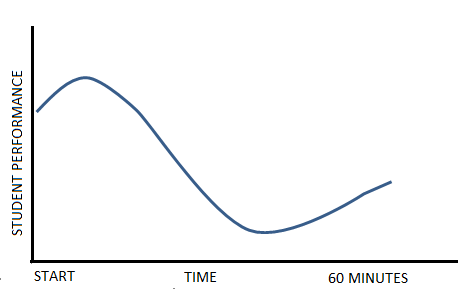
Learning curve in lecture (Bligh 1998)
The X-axis, the one which runs horizontally denotes lecture time and the Y-axis, the vertical line shows student performance. As discussed in the beginning, here the graphical line drops sharply during the lecture from a high level and shows a slight increase in attention towards the end.
Typical students’ attention cycle ranges from 10-12 minutes, i.e., 12 or 15 minutes long. A study has found that the attention span of note-taking students also declines over the course of the class. However, the gentle increase towards the end, whether one hour or less, indicates that the central part of the lecture can be ineffective and requires other possible strikes to boost attention.
Decline-Recovery-Decline Graph
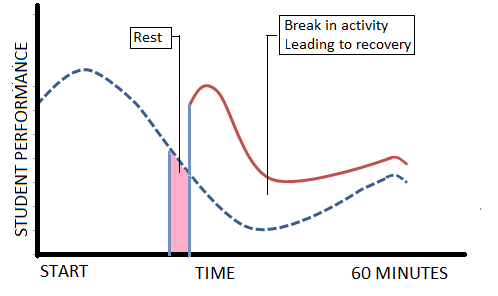
Learning curve in lecture (Bligh 1998)
The representation shows the duration of the lecture on the X-axis and student performance on the Y-axis. The graphical illustration displays that rest or breaks in between the lecture can improve the attention span though it slopes down again after a while. The line declines towards the end of the first half of the lecture and after the break, there is recovery for a few minutes and again recede before showing a rise as the class finishes. The recovery rate can count on the type of activities or the way speaker tackles the students.
Three Declines And Recoveries Graph
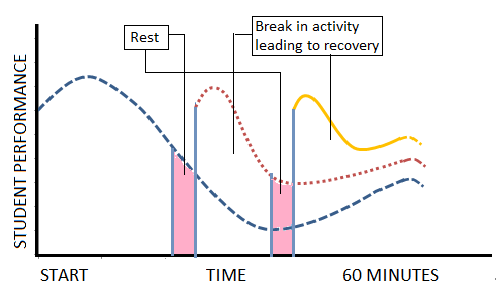
Learning curve in lecture (Bligh 1998)1
The Y-axis indicates student performance and X-axis the time of the lecture. The student performance increase as well as decrease thrice with respect to the activities between lectures. The peaks and fall of the line show the number of breaks introduced. Frequent intervals; let’s say one in 15 minutes can bring down the rate of attention lapse, same time balances the lost few minutes of “speaking” which ultimately reaps no grades!
All these explanations imply those of who are still not able to accomplish the perfect teacher title; grabbing student attention to drive performance is one significant way to advance learning and make lectures effective. During some classes, you may even see few sluggish faces or less-interested ones as lecture progress and might get that stumbled-feeling, do some brain-activating tricks; throw few random jokes or discuss on a happening issue or start a quiz. By the end of the lecture, you can collect the lecture notes of the first row students and check where all you failed, not able to maintain the attention graph. Assure the students that it’s not their problem and next time you will make the concept more illustrative and simple. An adept teacher adapts- measures not only the student performance but simultaneously looks for “change-up” in one’s lecture.
These demonstrations might imply that “attention” revolves only around classrooms. However, study (Harald Weinreich, Hartmut Obendorf, Eelco Herder, and Matthias Mayer, 2014)2 clearly tells that attention span is seen a drastic fall when compared to the previous decade. Let it not be the student community alone, the shocking consequence of our “always on” instant gratification on social life, with rise in work and family pressure have triggered constant spikes in attention span. When it comes to engaging team members during a meeting, research (Robert, 1876)3 states that a person soon becomes restless after 20 minutes (that too not sustained attention)- suggests that average attention span of the colleague is vital to the success rate of the conference. If the meeting is compelling, the degree of participation and energy to interact increase no matter how long the programme. The topic of the workshop can be recurring but to hold the concentration levels of the team is adequate. To keep up a steady graph among employees;
- Engage in some activities like an “ice-breaking” activity or a quick game lasting for a few seconds before the start of the session.
- It is good to speak for 20 minutes, tick of the next minute interact with the team-mates on the particular section.
- Every few minutes or seconds throw some attention captivating stimulus.
- Use of breakout rooms is advisable as to form small groups and to discuss the specific topic.
- Change the style of presentation.
If leaders are ready to embrace conference or a group discussion and transform into an “active forum”, getting work done is easier.
References
- Bligh (1998). What’s the use of Lectures. Exeter: Intellect.
- Harald Weinreich, Hartmut Obendorf, Eelco Herder, and Matthias Mayer: “Not Quite the Average: An Empirical Study of Web Use,” in the ACM Transactions on the Web, vol. 2, no. 1 (February 2008), article #5.
- Henry Martyn Robert, Robert’s Rules of Order (1876)
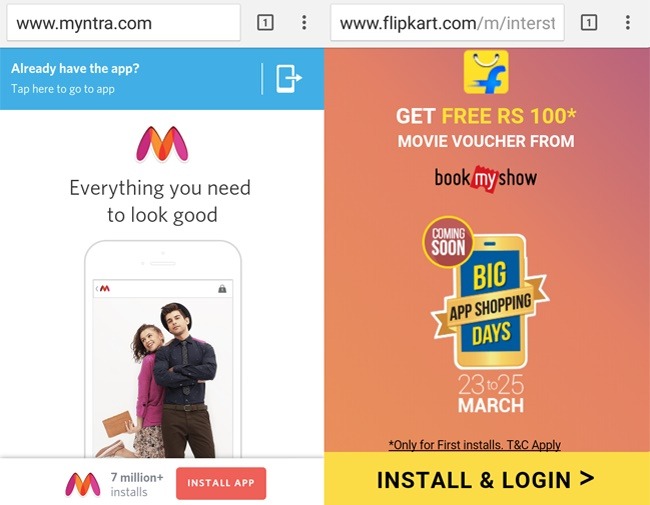
RETROSPECTING MOBILE APP ONLY STRATEGY OF FLIPKART
In a developing country like India where more smartphones are found than PCs and laptops, the move in focus of Flipkart along with Myntra onto the mobile app seems to be logical. Is it possible by these basic statistics to bring them the expected customers to use their mobile app for purchasing online? A purchasing journey is much more complex than researching and buying everything using a mobile. There are several touch points in the consumer journey to purchase. Mobile might be playing a bigger role in India in the consumer journey, but we can’t ignore the buying behaviour of Indian consumers.
As it is seen from the graph, the number of people using desktops were more until the year 2014 in India, when mobiles took over their role. Thus there is a rise in the use of mobiles since 2014. Whereas while considering the internet penetration of the developed world, the world globally and the developing world, the same seems to be much low among the developing worlds which include India. When the internet penetration is high among the developed countries and has risen quite well since the year 2000, the developing world seems to have risen at a very meagre level.
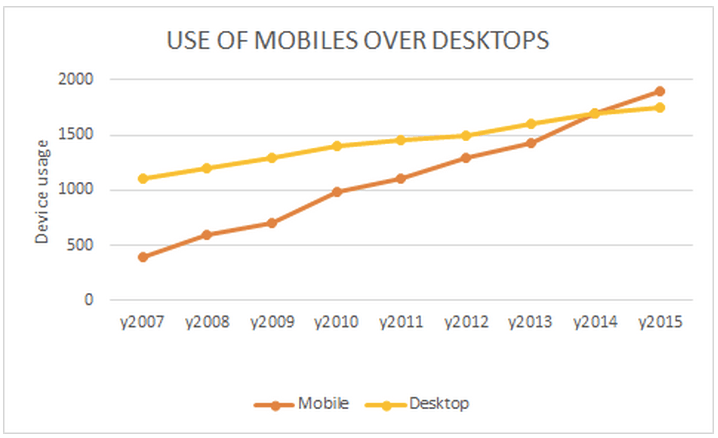
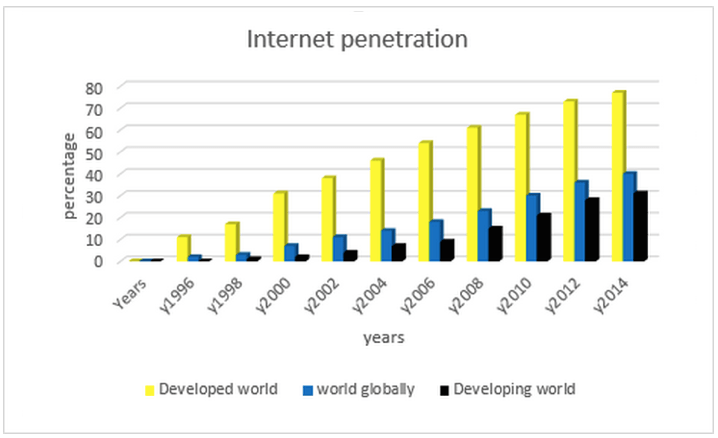
Heated debates and discussions are taking place on many websites and forums regarding this step taken up by Flipkart and Myntra. It was announced that Myntra would no longer be available on the desktop as well as the mobile website from May 15, 2015. Now it is Flipkart that is taking this major step into the app – only strategy within a year. The strategy may seem logical to Flipkart/Myntra at the helicopter view. It allows them to manage a single sales channel, data could be protected than mobile web, personalising shopping experience etc. However, there are several factors to be considered in Indian context such as consumer behaviour, growing internet adoption, connection speed, device usage, price sensitivity, availability of product information and recommendations, consumer ratings, the growing income of middle class.
INCREASED MOBILE TRAFFIC
The mobile traffic has increased 10 fold in the last eighteen months in India and according to Ericsson study, it was proved that the 58% of the people who do not use e-commerce services on smartphones said that they would be starting it within a year. This shows the increasing customer adoption of mobiles with internet facility in them.
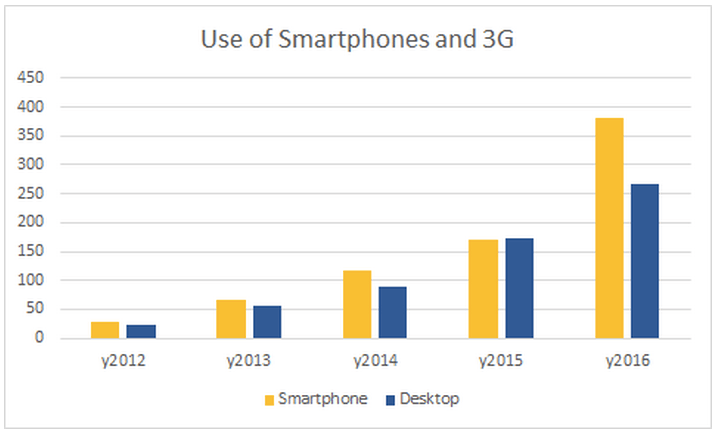
The number of individuals who used the internet through smartphone increased from 120 Mn to 140 Mn by 2014 in India. What the founders of the company say is that according to their observation, among the 90% traffic that Myntra acquired, 70% of the purchases were from Mobile apps which almost comes up to 9 million customers. This ensured them that the people who actually wanted to shop seem to be buying it through their personal accounts on their apps on phones. But this surge in the purchase from mobile apps must have been due to the additional discount that they offered for the purchases made through the mobile app. On top of this everyday new users are connected to internet in India and would eventually become matured users. They would then start internet shopping when they are matured internet users.
PERSONALIZATION
By converting all the purchases through the mobile app, they are trying for geo – targeting and to make shopping more personalized. Geo – targeting in geo – marketing and internet marketing is the method of determining the geolocation of a website visitor and delivering different content to that visitor based on his or her location, such as country, region/state, city, metro code/zip code, organization, IP address, ISP or other criteria. They say that they want customized feeds for everyone based on their interest. In short they want their customers to have the best purchasing experience. This might be their intention.
RESEARCH OR PURCHASE?
Till date every product could be seen in detail on our computers or laptops. Customers may have checked or browsed through the products through the mobile. But purchases are made only after close inspection of the product. Even then there have been news about cases where the dress did not look like how it was shown in the picture and that sort of complaints. In such a case, how would it be if everyone used the mobile app which has such low resolution to make a purchase worth thousands! (HuffingtonPost Online Shopping, 2015) That sounds hilarious and one would rather not get the product than get stuck with the wrong one. The product view inside the mobile app makes many categories vulnerable to no purchase. Many categories require big screen views. If the clothing category is considered, one – third of the goods are returned in many of the online purchasing websites.(Abcnews Sussana Kim, 2013)
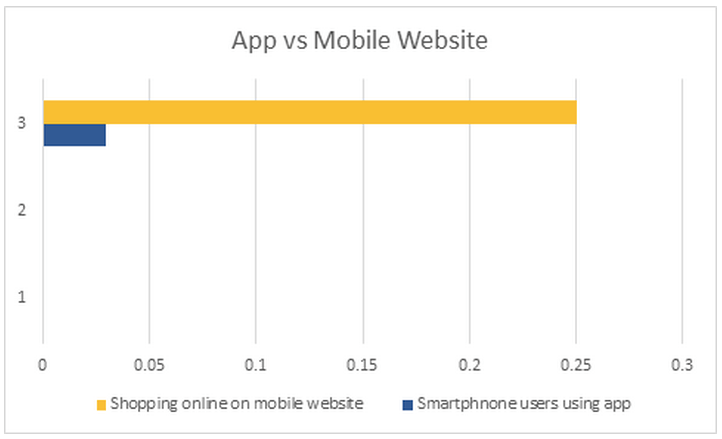
PUSH MESSAGE STRATEGY
Everyone might have a smartphone. But all do not work in the same smart fashion. Some are slow, some do not support apps, some phones are old and there are different types of phones available in the market these days and one buys the best that he can afford. When the mobile app strategy comes into the forefront, people will be forced to install the app if they have to make a purchase. But this would result in the consumption of too much of space (trak.in › Internet › Ecommerce) in one’s phone, one would rather not buy online than get their phone slow or stuck. Moreover some phones do not even support such apps. Thus the removal of mobile websites would not only result in the loss of customers but also in the denial of their privilege of making purchases online. The strategy of the company includes the generation of push messages every day to the app user. If a person has installed 20 apps, each app would send a minimum of 2-3 push notifications every day. This would sum up to around 50 notifications and with the other message notifications from friends and family, the number might rise to a hundred, which is too much for an individual to take. Earlier marketers could use unlimited SMS in order to let their customers know about the discounts and offers. Now, according to the regulations put forward by TRAI, there is a limit for the SMSs that can be sent. If a similar control comes for notifications, it would not be as bad as it sounded earlier.
The great gaming company Zynga came down as Facebook decided to not support Zynga notification system. Initially they supported the company and later they changed Facebook notifications into push notifications when the people would get Zynga notifications only if they wanted to.
A mobile phone is a much more affordable device and is handy when compared to a desktop. A person who uses a smartphone checks the phone at least 150 times a day and it would not be great if the individual has to go on clearing the push messages that is not necessary for him/ her then.(Are Flipkart and Myntra correct in following a mobile app-only strategy?, 2015)
INDIA – A PRICE SENSITIVE MARKET
India’s is a price sensitive market. In such a market people would never buy a product without comparing it with another one which might of a different brand and from a different place. But when people are constrained to the mobile apps, this option would be erased which thereby brings commotion among the customers as they lose the opportunity to compare and buy the best available in the market. In every manner this move made by Flipkart and Myntra may have a negative impact on the people and they have voiced it out as well. Around 58% of the people are against this strategy and it is just 19% that actually supports it. The rest do not even bother commenting on it.
![Source: [Online] ‘Flipkart to Shut Down Mobile Website; Will 213 Million Internet Users Of India Follow Suit?’ Author: Preetha Bose. Date: March 20, 2015.](https://cdn.prod.website-files.com/67e3ed379c42638b4aff7ec1/68061623f56e5368ec24d6a9_Responses-regarding-Flipkarts-mobile-app-only-strategy.png)
Author: Preetha Bose. Date: March 20, 2015.
The strategy of mobile app only purchase would put new start – ups at great risks. So unless and until a company is established and is sure that their customers would stay even they take this move, should they do it. But it is always said that a company should have multiple ways of marketing their products and this actually shows a major improvement and rise in their sale. This approach works only for the bigger developers as this assumes that almost 80–90% of users have your app installed on their Android phones at all times. India is primarily an Android market and hence this may not seem like a bad bet, but I personally do not think Flipkart or Myntra would have more than 25–30mn monthly active Android devices installed. Out of a 80+mn Android users, this still leaves around 60% of users in market not being able to find any results from Flipkart/Myntra when they do a Google search on their phones.
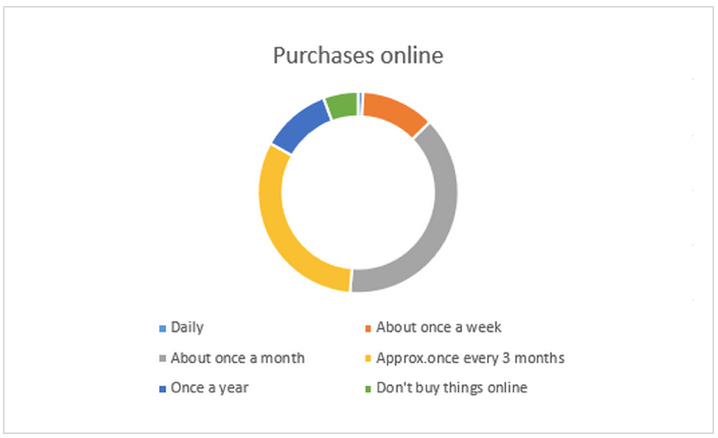
From the survey shown by ‘Information on the Survey ExperienceU.com’,(www.spiro.ir/photo/Do-You-S-Hop.html), people who made purchases online daily was just 0.8%. The people who made online purchases once a week was 11.9%. About 38.6% of people purchased online once a month and approximately 31.8% of people made online purchases once every 3 months. 11.3% purchased online every year. Less than 6% did not make online purchases at all.
MISSING THE NEW CUSTOMER’S OPPORTUNITY
The app – only strategy would restrict the new customers from purchasing from Flipkart or Myntra as they will have to download the app and install it in order to use it. As it pointed out earlier everyday new users are getting connected to the internet in India. There are still lot of opportunities to add new internet users as customers of Flipkart.
Every purchase start with a need. For eg: a when a mother delivers a baby they would look for ‘baby clothes’ for instance. They need information to satisfy their need. This would bring them to the search engines. Over 73% of product purchase start with a search on search engines (ThinkWithGoogle, Purchasing Journey, India). A Google search on a mobile might be the first touch point in the consumer buying journey. An app only strategy hinder the product information to be indexed in search engines. This restriction makes Flipkart non accessible to new internet users. Flipkart could push big TVCs and other offline campaigns to generate brand impressions. But the marketing budget to push big TVCs are humongous compared to the information accessible via search engines. Flipkart may not want to rely too much on big search engine such as Google in the long term strategy, but I think the decision of mobile app only strategy is quite early in the Indian scenario.
People usually install apps only after several considerations. They ask someone they know, be it a relative or a friend regarding the company and then decide whether to make a purchase or not. So people might end up being reluctant to install the app for a purchase or two. This users might be long term buyer with Flipkart/Myntra. According to the survey, just 38.6% of people shop at least once a month. For this, it is not necessary that they would be ready to install apps on their mobiles. This would in turn benefit competitors, especially Amazon which would not drop its mobile website scheme as they have enough and more customers. Search engines are provided for the people to know about various things that they are searching for. But if Flipkart moves on to the mobile app and removes its online websites, it would be really hard for a new customer to find and know about Flipkart and the chances are really low for them to know that such an app exists. This would deprive Flipkart of their new customers as the product information would be limited into the app alone.
EFFECT OF ANTI NET – NEUTRALITY SCHEME
From the recent Net-Neutrality and Airtel Zero episode we’ve seen that Flipkart and certainly not Myntra isn’t treated as a utility service and consumers do consider them expendable. Unlike Messaging(WhatsApp/WeChat/SnapChat) or Social network services(Facebook/Twitter/Instagram) which are used for many hours per month per user, my hypothesis is that an average user doesn’t transact more than couple of times a month on an e-commerce app. The mobile app only strategy may be prudent to serve the existing customer base by giving best customer experience. But the Indian market is not yet a matured market where many users are getting internet enabled every day. Flipkart mobile only strategy limits them to reach new internet users thereby helping Amazon to acquire those customers.
To sum up, Flipkart had either ways decided to move forward with their strategy. What they have to be aware of is that they are actually in a very competitive world where brand could circumpass the other with just one error made. The considerations of adding new internet users and understanding the buying behaviour of Indian customers are two areas both Flipkart or Myntra haven’t taken any consideration. Both points are very important from a business point of view. Let this move as they have planned have a successful impact on them as they had dreamt or it may lead to Amazon’s rise over Flipkart in the near future. So it is basically live or die!
References
- Mehta. Is it already time to kill your mobile website? [Online]March 23rd 2015.Available from: Your Story. http://yourstory.com/2015/03/app-only-strategy/. [Accessed: 12th May 2015].
- KJ Shashidhar.Flipkart, Myntra shut down their mobile websites and push to app- only mode. [Online]March 20th 2015.Available from: Medianama. http://www.medianama.com/2015/03/223-flipkart-myntra-shut-down-their-mobile-websites-and-push-to-app-only-model/.[Accessed: 11th May 2015].
- Dhapola. Myntra will app- only from My 15, to shut down desktop site; Flipkart nulls similar route. [Online]May 11th 2015.Available from: Indian Express. http://indianexpress.com/article/technology/social/myntra-will-be-app-only-from-15-may-as-flipkart-mulls-similar-route/.[Accessed:12th May 2015].
- PK Jayadevan.Online retailers like Flipkart & Snapdeal turn marketing focus to mobile. [Online]December 11th 2014.Available from: Economic Times. http://articles.economictimes.indiatimes.com/2014-12-11/news/56955238_1_amazon-india-flipkart-mobile-app.[Accessed:12th May 2015].
- FP Staff.Mobile first strategy: Flipkart just acquired mobile marketing for, Appiterate. [Online]April 29th 2015.Available from: F.Business. http://www.firstpost.com/business/mobile-first-strategy-flipkart-just-acquired-mobile-marketing-firm-appiterate-2219138.html.[Accessed:12th May 2015].




